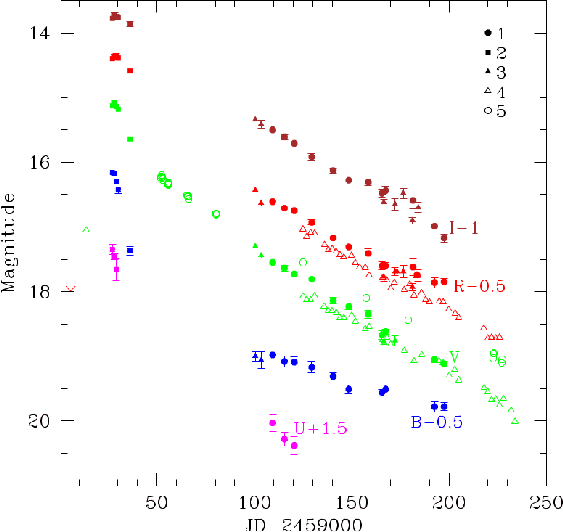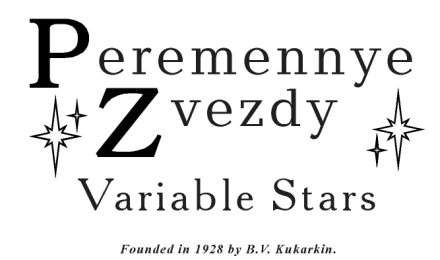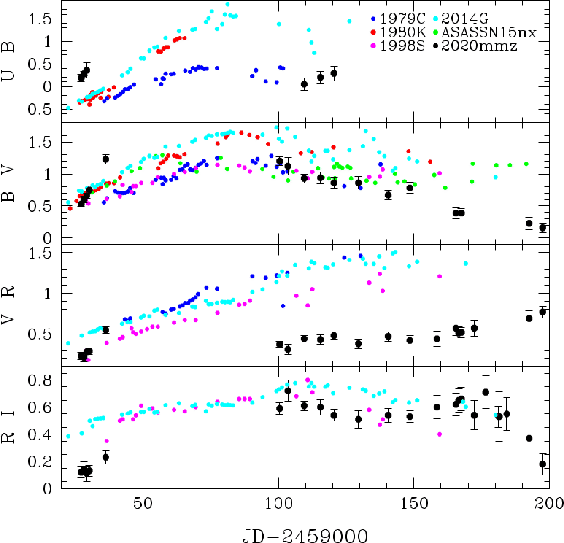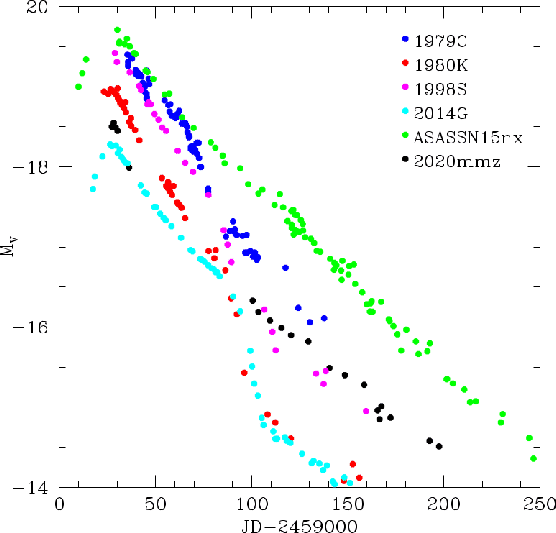|
Peremennye Zvezdy (Variable Stars) 42, No. 8, 2022 Received 5 October; accepted 17 October. |
Article in PDF |
|
DOI: 10.24412/2221-0474-2022-42-44-50
|
Photometric Observations of the Type II-L Supernova SN2020mmz
D. Yu. Tsvetkov1, N. N. Pavlyuk1, V. G. Metlov1, I. M. Volkov1,2, A. A. Belinski1, N. P. Ikonnikova1, M. A. Burlak1
- M.V.Lomonosov Moscow State University, Sternberg
Astronomical Institute, Universitetskii pr.13, 119234 Moscow,
Russia.
- Institute of Astronomy of Russian Academy of Sciences, Pyatnitskaya str., 48, 119017 Moscow, Russia
|
CCD |
Introduction
A large fraction of massive stars explode at the end of their
lives due to the gravitational collapse of their cores, such
events are recognized as core-collapse supernovae (CCSNe). Type II
SNe are hydrogen-rich CCSNe, this class is not uniform. Barbon et
al. (1979) proposed to divide SNe II into two major groups: SNe
II-P, which have nearly constant luminosity for a time interval of
![]() 100 days after maximum, and SNe II-L, which are
characterized by linear decline (in magnitudes) after maximum.
Later it became clear that objects with intermediate parameters
between SNe II-P and II-L also exist (Anderson et al., 2014). It
is supposed that SNe II-L have lower mass of hydrogen envelope,
the effect of energy input from interaction of the ejecta and
circumstellar matter on the light curve is also considered
(Blinnikov & Bartunov, 1993).
100 days after maximum, and SNe II-L, which are
characterized by linear decline (in magnitudes) after maximum.
Later it became clear that objects with intermediate parameters
between SNe II-P and II-L also exist (Anderson et al., 2014). It
is supposed that SNe II-L have lower mass of hydrogen envelope,
the effect of energy input from interaction of the ejecta and
circumstellar matter on the light curve is also considered
(Blinnikov & Bartunov, 1993).
In this paper, we present the results of our photometric observations of bright type II-L Supernova SN 2020mmz.
The discovery by ZTF1 of a
transient source at
![]() on 2020-06-13.22 UT (JD2459013.72)
was reported by ALeRCE broker (Forster et al., 2020).
It was detected with
on 2020-06-13.22 UT (JD2459013.72)
was reported by ALeRCE broker (Forster et al., 2020).
It was detected with
![]() ABmag, the last
non-detection limits the brightness to
ABmag, the last
non-detection limits the brightness to
![]() ABmag
on 2020-06-05.25 UT (JD2459005.75), 8 days before discovery.
ABmag
on 2020-06-05.25 UT (JD2459005.75), 8 days before discovery.
The host galaxy is NGC 2814, a type Sb galaxy at redshift
![]() , in a pair with NGC 2820, Sc edge-on galaxy with
nearly the same redshift2.
, in a pair with NGC 2820, Sc edge-on galaxy with
nearly the same redshift2.
The classification spectrum was obtained on 2020-06-22.87 UT by Balcon (2020), who found good fits to the spectra of type II SNe. The photometric observations of SN2020mmz were reported by ZTF3and Gaia4.
Observations and reductions
We carried out photometric observations of SN 2020mmz in the
![]() bands from 2020-06-26 to 2020-12-14 with the 60-cm
reflector of the Caucasus Mountain Observatory of Sternberg
Astronomical Institute (K60) (Berdnikov et al., 2020), 60-cm
telescope of the Crimean Observatory of Sternberg Astronomical
Institute (C60), and with the 1-m reflector of the Simeiz
Observatory (S100) (Nikolenko et al., 2019).
bands from 2020-06-26 to 2020-12-14 with the 60-cm
reflector of the Caucasus Mountain Observatory of Sternberg
Astronomical Institute (K60) (Berdnikov et al., 2020), 60-cm
telescope of the Crimean Observatory of Sternberg Astronomical
Institute (C60), and with the 1-m reflector of the Simeiz
Observatory (S100) (Nikolenko et al., 2019).
The standard image reductions and photometry were performed using IRAF5. Photometric measurements of the SN were made relative to local standard stars using PSF fitting with the IRAF DAOPHOT package.
The SN was located near the ridge line of a nearly edge-on galaxy,
so the subtraction of galaxy background was necessary. The
template images for subtraction were obtained at the K60 telescope
in March 2022, when the SN had faded. The image of SN2020mmz
with local standards is shown in Fig. 1, the magnitudes of the
comparison stars were taken from the
SDSS6and PanSTARRS7databases and transferred to the Johnson-Cousins ![]() magnitudes using relations from Jester et al. (2005) and Kostov &
Bonev (2018).
magnitudes using relations from Jester et al. (2005) and Kostov &
Bonev (2018).
The magnitudes of comparison stars are reported in Table 1, and the results of the photometry of SN2020mmz are presented in Table 2.
 |
Fig. 1.
SN 2020mmz and local standard stars. The
image was obtained at the K60 telescope in the |
| Star | |||||
| 1 | 15.09 | 14.89 | 14.31 | 13.96 | 13.60 |
| 2 | 15.36 | 14.93 | 14.13 | 13.65 | 13.21 |
| 3 | 16.32 | 15.64 | 14.77 | 14.24 | 13.79 |
| 4 | 16.18 | 15.87 | 15.14 | 14.70 | 14.29 |
| 5 | 16.55 | 16.37 | 15.65 | 15.22 | 14.81 |
| 6 | 17.14 | 16.49 | 15.58 | 15.03 | 14.55 |
| 7 | 16.98 | 16.68 | 15.91 | 15.44 | 15.02 |
| 8 | 17.10 | 16.92 | 16.24 | 15.83 | 15.39 |
| 9 | 17.23 | 16.93 | 16.14 | 15.67 | 15.23 |
| JD |
Tel. | ||||||||||
| 27.30 | 15.85 | 0.08 | 15.66 | 0.02 | 15.13 | 0.03 | 14.90 | 0.03 | 14.78 | 0.03 | S100 |
| 28.29 | 15.96 | 0.04 | 15.68 | 0.03 | 15.08 | 0.04 | 14.87 | 0.04 | 14.73 | 0.04 | S100 |
| 29.28 | 16.16 | 0.17 | 15.80 | 0.03 | 15.14 | 0.03 | 14.86 | 0.04 | 14.75 | 0.04 | S100 |
| 30.27 | 15.93 | 0.05 | 15.18 | 0.03 | 14.89 | 0.03 | 14.76 | 0.03 | S100 | ||
| 36.28 | 16.87 | 0.07 | 15.64 | 0.03 | 15.09 | 0.03 | 14.86 | 0.04 | S100 | ||
| 100.55 | 18.50 | 0.07 | 17.30 | 0.02 | 16.93 | 0.03 | 16.34 | 0.03 | C60 | ||
| 103.56 | 18.56 | 0.13 | 17.44 | 0.04 | 17.13 | 0.05 | 16.41 | 0.06 | C60 | ||
| 109.51 | 18.53 | 0.13 | 18.48 | 0.06 | 17.55 | 0.03 | 17.11 | 0.03 | 16.50 | 0.02 | K60 |
| 115.54 | 18.78 | 0.11 | 18.58 | 0.08 | 17.64 | 0.04 | 17.21 | 0.04 | 16.61 | 0.03 | K60 |
| 120.52 | 18.59 | 0.08 | 17.73 | 0.03 | 17.25 | 0.03 | 16.71 | 0.02 | K60 | ||
| 129.51 | 18.88 | 0.14 | 18.67 | 0.09 | 17.81 | 0.04 | 17.43 | 0.04 | 16.92 | 0.05 | K60 |
| 140.54 | 18.81 | 0.06 | 18.14 | 0.05 | 17.67 | 0.03 | 17.13 | 0.04 | K60 | ||
| 148.53 | 19.01 | 0.07 | 18.23 | 0.05 | 17.81 | 0.03 | 17.28 | 0.03 | K60 | ||
| 158.51 | 18.35 | 0.06 | 17.91 | 0.07 | 17.31 | 0.05 | K60 | ||||
| 165.49 | 19.06 | 0.05 | 18.67 | 0.07 | 18.10 | 0.06 | 17.48 | 0.06 | K60 | ||
| 166.42 | 18.78 | 0.04 | 18.27 | 0.07 | 17.62 | 0.05 | C60 | ||||
| 167.43 | 19.01 | 0.06 | 18.62 | 0.04 | 18.10 | 0.05 | 17.44 | 0.07 | K60 | ||
| 172.25 | 18.76 | 0.08 | 18.19 | 0.08 | 17.65 | 0.09 | C60 | ||||
| 173.24 | 18.19 | 0.08 | C60 | ||||||||
| 176.43 | 18.19 | 0.09 | 17.48 | 0.08 | C60 | ||||||
| 181.23 | 18.43 | 0.06 | 17.90 | 0.05 | C60 | ||||||
| 181.48 | 19.51 | 0.18 | 18.12 | 0.13 | 17.59 | 0.13 | K60 | ||||
| 183.45 | 19.37 | 0.12 | 18.89 | 0.09 | 18.24 | 0.05 | K60 | ||||
| 184.33 | 18.25 | 0.09 | 17.70 | 0.08 | C60 | ||||||
| 192.59 | 19.28 | 0.08 | 19.05 | 0.05 | 18.36 | 0.08 | 17.99 | 0.04 | K60 | ||
| 197.53 | 19.28 | 0.06 | 19.11 | 0.05 | 18.35 | 0.05 | 18.17 | 0.06 | K60 |
Results and conclusions
The light curves are shown in Fig. 2. The upper limit on JD 2459005.75 and the discovery magnitude on JD 2459013.72 allow us to conclude that our observations started near the maximum light.
The maximum light was reached on JD 2459028![]() in the
in the ![]() bands, the maximum magnitudes are
bands, the maximum magnitudes are
![]() ,
,
![]() ,
,
![]() with uncertainties about 0.05
mag. The maximum in the
with uncertainties about 0.05
mag. The maximum in the ![]() filters was probably reached 1-3
days earlier. After the maximum, the brightness decline was very
fast in the
filters was probably reached 1-3
days earlier. After the maximum, the brightness decline was very
fast in the ![]() bands: 0.17 and 0.11 mag day
bands: 0.17 and 0.11 mag day![]() ,
respectively. Our observations have a large gap between JD 2459036
and 2459100. After the gap, the decline was much slower: 0.0088,
0.018, 0.015, 0.019 mag day
,
respectively. Our observations have a large gap between JD 2459036
and 2459100. After the gap, the decline was much slower: 0.0088,
0.018, 0.015, 0.019 mag day![]() for the
for the ![]() bands.
The data from ZTF in
bands.
The data from ZTF in ![]() bands and from Gaia in Gaia-G filter
show the rate of decline similar to our results for the
bands and from Gaia in Gaia-G filter
show the rate of decline similar to our results for the ![]() bands: about 0.016 mag day
bands: about 0.016 mag day![]() . The Gaia magnitudes partly
fill the gap in our data, they show that the slow decline has
started at JD2459050 or even earlier, so we can suppose that the
change of slope occurred in the JD 2459040-50 interval.
. The Gaia magnitudes partly
fill the gap in our data, they show that the slow decline has
started at JD2459050 or even earlier, so we can suppose that the
change of slope occurred in the JD 2459040-50 interval.
The location of SN2020mmz in a nearly edge-on spiral galaxy
allows us to expect high reddening in the host galaxy. The color
curves of SN2020mmz are presented in Fig. 3 and compared to the
color curves of five SNe II-L for which the reddening was small
and reliably determined: 1979C (Balinskaya et al., 1980), 1980K
(Buta, 1982), 1998S (Fassia et al., 2000), 2014G (Bose et al.,
2016), and ASASSN2015nx (Bose et al., 2018). The shifts of the
![]() color curves of the five SNe for the best match with the
curve for SN2020mmz near maximum light allow us to estimate the
reddening:
color curves of the five SNe for the best match with the
curve for SN2020mmz near maximum light allow us to estimate the
reddening:
![]() mag. The observed colors for
SN2020mmz are plotted in Fig. 3, while the color curves of SNe
from the comparison sample were shifted vertically, by an amount
calculated as the difference between the reddening of comparison
SNe and SN2020mmz. Figure 3 reveals large differences between
color curves of SNe II-L in the shape of the curves and in the
values of colors. For SN2020mmz, the difference near maximum
light is larger for the
mag. The observed colors for
SN2020mmz are plotted in Fig. 3, while the color curves of SNe
from the comparison sample were shifted vertically, by an amount
calculated as the difference between the reddening of comparison
SNe and SN2020mmz. Figure 3 reveals large differences between
color curves of SNe II-L in the shape of the curves and in the
values of colors. For SN2020mmz, the difference near maximum
light is larger for the ![]() color, where SN2020mmz is
significantly redder than other SNe, and for the
color, where SN2020mmz is
significantly redder than other SNe, and for the ![]() color,
where SN2020mmz is bluer. But at late epochs, the greater
difference is that for the
color,
where SN2020mmz is bluer. But at late epochs, the greater
difference is that for the ![]() color, as SN2020mmz becomes
bluer than other SNe by about 1 mag.
color, as SN2020mmz becomes
bluer than other SNe by about 1 mag.
The absolute ![]() -band light curve of SN 2020mmz is presented in
Fig. 4; the light curves of the five SNe II-L are plotted for
comparison. The distance modulus
-band light curve of SN 2020mmz is presented in
Fig. 4; the light curves of the five SNe II-L are plotted for
comparison. The distance modulus ![]() was computed for
SN2020mmz based on its reported redshift and
was computed for
SN2020mmz based on its reported redshift and ![]() km
s
km
s![]() Mpc
Mpc![]() . Using the data on maximum magnitude and
extinction presented earlier, and assuming
. Using the data on maximum magnitude and
extinction presented earlier, and assuming ![]() , we can
calculate the maximum absolute magnitudes
, we can
calculate the maximum absolute magnitudes
![]() . The accuracy of these estimates is low due
to possibility of large errors in determination of the color
excess and uncertainty of the parameter
. The accuracy of these estimates is low due
to possibility of large errors in determination of the color
excess and uncertainty of the parameter ![]() .
.
The data on the five SNe II-L were taken from the references
reported earlier. The maximum absolute magnitude and general
behavior of the light curve for SN2020mmz do not differ from the
other SNe. The peculiar feature of SN2020mmz is the fast decline
for the first ![]() 20 days after maximum. For the other SNe II-L,
the decline is more monotonous and the rate for the first 20 days
in the
20 days after maximum. For the other SNe II-L,
the decline is more monotonous and the rate for the first 20 days
in the ![]() band is between 0.028 and 0.049 mag day
band is between 0.028 and 0.049 mag day![]() . For
SN2020mmz, this rate is 0.11 mag day
. For
SN2020mmz, this rate is 0.11 mag day![]() , more than 2 times
faster than the largest rate for the SNe II-L from our comparison
sample.
, more than 2 times
faster than the largest rate for the SNe II-L from our comparison
sample.
 |
Fig. 2.
The light curves of SN 2020mmz. 1,
2, 3: our results, obtained with the K60, S100, C60 telescopes,
respectively; 4: ZTF magnitudes ( |
Acknowledgements. This study was performed using the equipment purchased through the funds of the Development Program of the Lomonosov Moscow State University. The work was supported by the Scientific and Educational School of the Lomonosov Moscow State University "Fundamental and Applied Space Research". The work of I. Volkov was supported by a scholarship of Slovak Academic Information Agency SAIA.
References:
Anderson, J.P., Gonzalez-Gaitan, S., Hamuy, M., et al., 2014, Astrophys. J., 786, 67
Balinskaia, I.S., Bychkov, K.V., Neizvestnyi, S.I., 1980, Astron. & Astrophys., 85, L19
Balcon, C., 2020, TNS Classification Report, No. 6945
Barbon, R., Ciatti, F., Rosino, L., 1979, Astron. & Astrophys., 72, 287
Berdnikov, L.N., Belinskii, A.A., Shatskii, N.I., et al., 2020, Astron. Reports, 64, 310
Blinnikov, S.I., Bartunov, O.S., 1993, Astron. & Astrophys., 273, 106
Bose, S., Kumar, B., Misra, K., et al., 2016, Mon. Notices Roy. Astron. Soc., 455, 2712
Bose, S., Dong, S., Kochanek, C.S., et al., 2018, Astrophys. J., 862, 107
Buta, R.J., 1982, Publ. Astron. Soc. Pacific, 94, 578
Fassia, A., Meikle, W.P.S., Vacca, W.D., et al., 2000, Mon. Notices Roy. Astron. Soc., 318, 1093
Forster, F., Bauer, F.E., Galbany, L., et al., 2020, TNS Astronomical Transient Report, No. 73897
Jester, S., Schneider, D.P., Richards, G.T., et al., 2005, Astron. J., 130, 873
Kostov, A., Bonev, T., 2018, Bulgarian Astronomical Journal, 28, 3
Nikolenko, I.V., Kryuchkov, S.V., Barabanov, S.I., Volkov, I.M., 2019, Nauchnye Trudy Instituta Astronomii RAN, 4, 85


